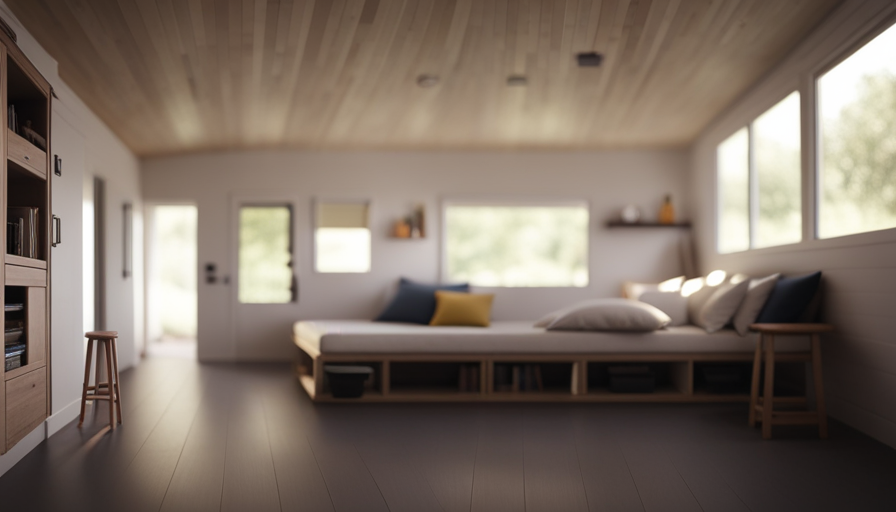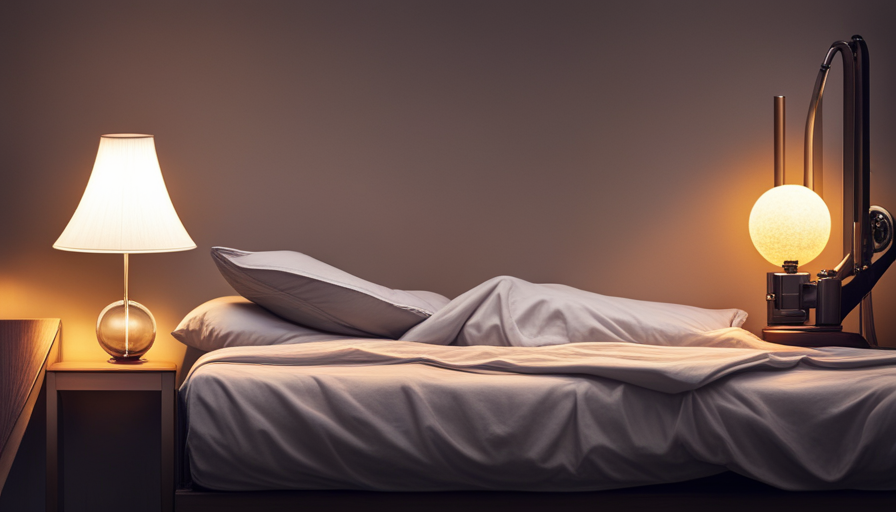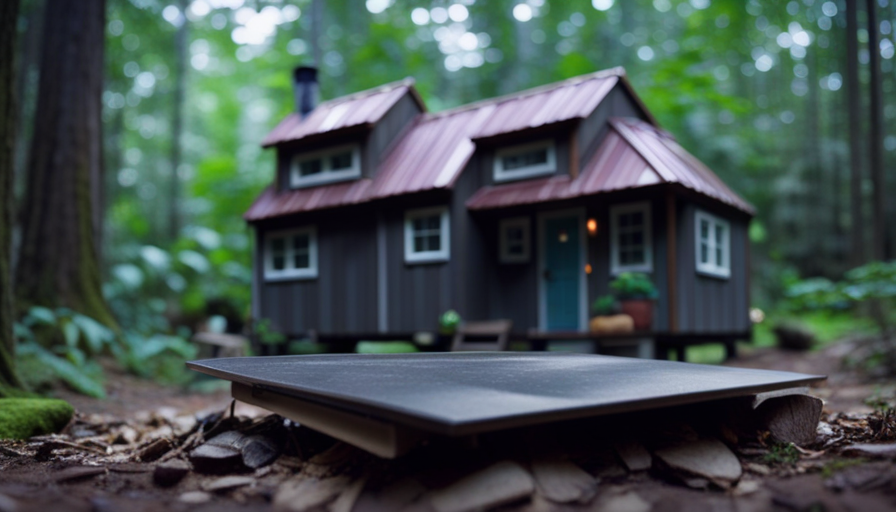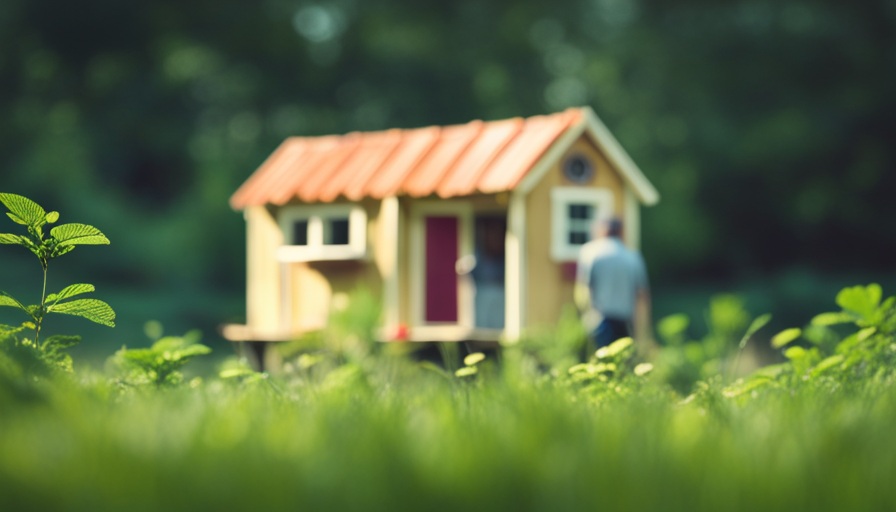The process of selling a small house can be likened to navigating a maze of choices. It requires careful planning, targeted advertising, and a deep understanding of the niche market for these compact homes. Just like a skilled captain guides a ship through uncharted waters, I will navigate you towards a successful sale of your tiny house.
In this article, I will share my expertise on how to attract potential buyers and maximize the appeal of your tiny house. We will explore the importance of highlighting its unique features and benefits, staging and photographing it to perfection, and determining the right price to ensure a successful sale.
Additionally, I will reveal the secrets of creating a compelling listing, networking with like-minded enthusiasts, and even offering financing options or lease-to-own agreements.
So, grab your compass and join me on this exciting journey of selling your tiny house with confidence and finesse. Together, we will navigate the turbulent waters of the real estate market and emerge victorious, ensuring a smooth and profitable sale of your cherished tiny abode.
Key Takeaways
- Understanding the target market and highlighting the unique features and benefits of a tiny house are crucial for a successful sale.
- Utilizing various marketing strategies such as social media, websites, and open house events can attract potential buyers.
- Staging and photographing the tiny house effectively is important to maximize appeal.
- Partnering with a real estate agent or tiny house specialist can provide guidance and support throughout the selling process and increase the chances of a successful sale.
Understand the Market for Tiny Houses
So, do you know who’s actually interested in buying these adorable tiny houses? Understanding the demand for tiny houses and identifying target markets is crucial when it comes to selling them.
The market for tiny houses has been steadily growing over the years, attracting a diverse range of potential buyers. One of the main target markets for tiny houses is millennials, who’re seeking affordable and sustainable housing options. They’re drawn to the minimalist lifestyle and the idea of reducing their ecological footprint.
Additionally, retirees looking to downsize and simplify their lives are another key market for tiny houses. The convenience, lower cost of living, and ability to travel are appealing to this demographic.
Furthermore, individuals and families interested in vacation homes or secondary dwellings are also potential buyers.
By understanding the demand for tiny houses and identifying these target markets, you can tailor your marketing and selling strategies accordingly. Highlighting the unique features and benefits of your tiny house will further entice potential buyers.
Highlight the Unique Features and Benefits of Your Tiny House
Show off the incredible features and advantages of your cozy home to captivate potential buyers! When marketing your tiny house, it’s important to highlight its unique features that set it apart from traditional homes.
Emphasize the space-saving design, efficient use of resources, and low maintenance requirements. Showcase the clever storage solutions, such as built-in shelving and hidden compartments, which make the most out of every square inch. Additionally, emphasize the eco-friendly aspects of your tiny house, such as solar panels, composting toilets, and rainwater collection systems.
To effectively market your tiny house, utilize various strategies. Utilize social media platforms to showcase stunning photos and videos that highlight the beauty and functionality of your tiny house. Create a website or blog to provide detailed information about the construction process, materials used, and any unique features. Consider hosting open house events or participating in tiny house festivals to reach a larger audience.
By highlighting the features and benefits of your tiny house, you can attract potential buyers who are seeking a more minimalist and sustainable lifestyle. Transitioning into the subsequent section about staging and photographing your tiny house for maximum appeal, let’s explore how to present your cozy abode in the best possible light.
Stage and Photograph Your Tiny House for Maximum Appeal
To truly capture the charm and allure of your little haven, it’s time to set the stage and snap some captivating photos that will make hearts flutter.
Staging your tiny house is crucial as it allows potential buyers to envision themselves living in the space. Start by decluttering and organizing your tiny house, making sure each area is clean and well-maintained. Remove personal items to create a neutral canvas that appeals to a wider audience.
When staging your tiny house, focus on highlighting its unique features and creating a sense of space. Use furniture and decor that complement the size and style of the house, maximizing functionality without overcrowding. Consider using multipurpose furniture to showcase the versatility of the space.
Professional photography is essential in showcasing your tiny house in the best light. Hire a professional photographer who specializes in architectural or real estate photography. They’ll know how to capture the essence of your tiny house, highlighting its best angles and features. High-quality, well-lit photos will attract more potential buyers and set your listing apart from the competition.
By staging and photographing your tiny house with care and attention to detail, you’ll create a strong first impression that draws in potential buyers.
Now that your tiny house is ready to be showcased, it’s time to determine the right price for your tiny house and ensure a successful sale.
Determine the Right Price for Your Tiny House
Pricing your compact dwelling can be a tricky task, but finding the sweet spot between profit and affordability is essential for a successful sale. When determining the right price for your tiny house, consider these three factors:
-
Market Research: Conduct thorough research to understand the current market trends and prices for similar tiny houses in your area. Look at online listings, visit open houses, and consult with real estate agents specializing in tiny homes. This will give you a better idea of what buyers are willing to pay.
-
Unique Features: Highlight any unique features or upgrades that your tiny house offers. These can add value and justify a higher price. Whether it’s custom-built furniture, energy-efficient appliances, or innovative storage solutions, emphasize these selling points to potential buyers.
-
Negotiation Skills: Be prepared to negotiate with potential buyers. Understand your bottom line and have a clear idea of how much you are willing to negotiate. It’s important to strike a balance between getting a fair price and ensuring a smooth transaction.
By determining the right price and honing your negotiation skills, you’ll be well-equipped to attract potential buyers and secure a successful sale.
In the next section, we’ll discuss how to create a compelling listing for your tiny house.
Create a Compelling Listing for Your Tiny House
Crafting an irresistible listing for your cozy abode is the key to attracting potential buyers and maximizing your chances of a successful sale. When it comes to selling a tiny house, showcasing its interior design and storage solutions is crucial.
Start by highlighting the clever ways you’ve utilized the limited space to create a functional and stylish living area. Share tips on how to make the most of small living spaces, such as using multipurpose furniture and incorporating clever storage solutions like hidden compartments and built-in shelving.
In your listing, paint a picture of the cozy and inviting atmosphere your tiny house offers. Use descriptive language to convey the charm and character of each room, emphasizing the unique features and finishes. Additionally, include high-quality, well-lit photographs that capture the essence of your tiny house’s interior. Potential buyers will appreciate being able to visualize themselves living in the space.
When it comes to storage solutions, highlight any innovative features or custom-built options you’ve incorporated into your tiny house. Showcase how every nook and cranny has been maximized for storage, helping potential buyers see the potential for organization and functionality in the limited space.
By creating a compelling listing that showcases the interior design and storage solutions of your tiny house, you’ll captivate potential buyers and increase your chances of a successful sale. Once you’ve crafted the perfect listing, it’s time to utilize online platforms and social media for marketing, expanding your reach and attracting even more interested buyers.
Utilize Online Platforms and Social Media for Marketing
Utilizing online platforms and social media for marketing is essential in reaching a wider audience and increasing the chances of a successful sale. In today’s digital age, online marketing has become a powerful tool to promote and sell products, including tiny houses. Here are five reasons why you should leverage online marketing and social media advertising to sell your tiny house:
-
Wider reach: By utilizing online platforms and social media, you can reach potential buyers from all over the world, expanding your market significantly.
-
Targeted advertising: Online marketing allows you to target specific demographics and interests, ensuring that your tiny house is seen by the right audience.
-
Cost-effective: Compared to traditional advertising methods, online marketing is often more affordable and provides a higher return on investment.
-
Engagement and interaction: Social media platforms allow you to engage with potential buyers directly, answering their questions and showcasing the unique features of your tiny house.
-
Visual appeal: With the ability to post photos and videos, online platforms and social media make it easy to showcase the beauty and functionality of your tiny house.
By utilizing online marketing and social media advertising, you can effectively market your tiny house and connect with potential buyers.
Next, let’s explore how you can network with tiny house enthusiasts and communities to further enhance your chances of a successful sale.
Network with Tiny House Enthusiasts and Communities
By connecting with like-minded individuals and engaging with tiny house enthusiasts and communities, I have tapped into a network of passionate individuals who have provided me with valuable insights and support throughout my selling journey. Networking events have been particularly helpful in meeting potential buyers and spreading the word about my tiny house. These events provide a platform for me to showcase the unique features and benefits of my tiny house, as well as engage with people who share a similar interest in tiny house living.
Additionally, by connecting with other tiny house enthusiasts and communities online, I have been able to reach a wider audience and generate more interest in my tiny house. Social media platforms, such as Facebook groups and Instagram accounts dedicated to tiny houses, have allowed me to share photos, videos, and information about my tiny house, attracting potential buyers from all over.
Furthermore, networking with other tiny house enthusiasts has provided me with valuable insights into tiny house construction techniques and design trends. By engaging in conversations and sharing experiences, I have been able to refine my selling pitch and highlight the unique features of my tiny house.
Considering offering financing options or lease-to-own agreements can be a great way to attract potential buyers who may not have the funds upfront.
Consider Offering Financing Options or Lease-to-Own Agreements
Consider exploring the option of providing financing or lease-to-own arrangements, allowing potential buyers to envision themselves living in and owning your charming, compact abode. Offering financing options can make your tiny house more accessible to a wider range of buyers who may not have the full purchase amount upfront. By breaking down the cost into manageable installments, you can attract more interest and increase your chances of a successful sale.
When considering financing options, it’s important to determine the terms that work best for both parties involved. This could include the interest rate, repayment period, and any additional fees. By being transparent and flexible, you can build trust with potential buyers and create a mutually beneficial agreement.
Lease-to-own agreements are another attractive option to consider. This arrangement allows interested buyers to rent the tiny house for a specified period while making monthly payments towards eventual ownership. It gives them the opportunity to try out the lifestyle and determine if it’s the right fit before committing to a purchase.
By providing financing options or lease-to-own agreements, you demonstrate your willingness to work with potential buyers and accommodate their individual needs. This flexibility can set you apart from other sellers and increase the likelihood of a successful sale. Being responsive and attentive to inquiries and requests will further enhance your chances of finding the perfect buyer for your tiny house.
Be Responsive and Flexible with Potential Buyers
Being readily available and adaptable to the needs of potential buyers can make all the difference in finding the perfect match for your cozy, pint-sized dwelling. When selling a tiny house, it’s important to prioritize responsive communication and showcase your negotiation skills.
Here are three key reasons why being responsive and flexible can help you sell your tiny house quickly and effectively:
-
Build trust: By promptly responding to inquiries and being available for showings, you demonstrate your commitment as a seller. This builds trust and reassures potential buyers that you’re serious about selling your tiny house.
-
Address concerns: Tiny houses often come with unique challenges and limitations. By being responsive, you can address any concerns or questions potential buyers may have. You can provide them with the necessary information to make an informed decision and alleviate any doubts they may have.
-
Accommodate negotiations: Being flexible with potential buyers can open up opportunities for negotiations. Whether it’s adjusting the price or offering additional incentives, being responsive and adaptable shows that you’re willing to work with buyers to reach a mutually beneficial agreement.
By being responsive and flexible, you create a positive buying experience for potential buyers and increase the chances of selling your tiny house.
Next, I’ll discuss the importance of working with a real estate agent or tiny house specialist for guidance and support in the selling process.
Work with a Real Estate Agent or Tiny House Specialist for Guidance and Support
Partnering with a real estate agent or tiny house specialist can provide you with invaluable guidance and support throughout the selling process, ensuring a smooth and successful transaction. These professionals have a deep understanding of the real estate market and can help you navigate through the complexities of selling a tiny house. They have access to a wide network of potential buyers and can market your property effectively to reach the right audience.
In addition to their expertise, real estate agents and tiny house specialists can also assist you with the financial aspects of selling your tiny house. They can provide advice on pricing your home competitively in the market and help you negotiate the best deal with potential buyers. They can also guide you through the process of obtaining financing for your tiny house, if needed, and provide you with information on available options.
To give you a better idea of the benefits of working with a real estate agent or tiny house specialist, take a look at the table below:
| Benefits of Working with a Real Estate Agent or Tiny House Specialist | |
|---|---|
| Expertise in the real estate market | Access to a wide network of potential buyers |
| Knowledge of tiny home financing options | Assistance with pricing and negotiation |
| Guidance and support throughout the selling process | Marketing your tiny house effectively |
By partnering with a real estate agent or tiny house specialist, you can maximize your chances of selling your tiny house quickly and for a fair price. Their knowledge, experience, and network can make all the difference in the selling process and ensure a successful transaction.
Frequently Asked Questions
What are some common financing options available for purchasing a tiny house?
When it comes to financing a tiny house, there are a few options to consider.
One popular choice is securing a personal loan, which offers flexibility but may come with higher interest rates.
Another option is to explore RV loans, which often have lower interest rates but may require the tiny house to meet certain criteria.
Lastly, some people choose to save up and pay cash, avoiding any debt altogether.
Each option has its pros and cons, so it’s important to weigh them carefully before making a decision.
How will you finance your tiny dream?
How can I effectively stage and photograph my tiny house to attract potential buyers?
To effectively stage and photograph your tiny house and attract potential buyers, consider these staging tips and photography techniques.
Start by decluttering and organizing the space, highlighting its unique features and maximizing natural light. Use neutral colors and minimal decor to create a clean and inviting atmosphere.
When it comes to photography, capture wide-angle shots and use proper lighting to showcase the space. Don’t forget to emphasize the functionality and versatility of your tiny house to appeal to prospective buyers.
Are there any specific online platforms or social media groups dedicated to buying and selling tiny houses?
Looking to sell your tiny house? Well, I’ve got some exciting news for you!
There are fantastic online marketplaces and Facebook groups dedicated specifically to buying and selling tiny houses. These platforms provide a targeted audience of potential buyers who are actively seeking out tiny homes.
With their vast reach and engaged community, you can showcase your tiny house to interested individuals who are eager to make a purchase. It’s a fantastic opportunity to connect with the right buyers and sell your tiny house quickly and efficiently.
What factors should I consider when determining the right price for my tiny house?
When determining the right price for my tiny house, I consider several factors.
First, I conduct a comparable market analysis to see how similar houses in my area are priced. This helps me understand the market demand and competition.
I also take into account the size, condition, and unique features of my tiny house. Additionally, I consider any recent upgrades or renovations that may increase its value.
By carefully assessing these factors, I can price my tiny house competitively and attract potential buyers.
How can I network with tiny house enthusiasts and communities to increase the chances of selling my tiny house?
To increase the chances of selling my tiny house, I actively network with fellow tiny house enthusiasts and communities. I attend networking events specifically designed for this niche market, where I can connect with potential buyers and learn about the latest tiny house marketing strategies.
By immersing myself in this community, I gain valuable insights and build relationships that enhance my chances of selling my tiny house to the right buyer.
Conclusion
So there you have it, selling a tiny house requires a strategic approach.
By understanding the market, highlighting unique features, staging and photographing effectively, determining the right price, creating a compelling listing, networking with enthusiasts, offering financing options, being responsive and flexible, and seeking guidance from experts, you can increase your chances of a successful sale.
Remember, selling a tiny house may require some extra effort, but with the right approach, you can find the perfect buyer for your cozy and sustainable home.
Hi, I’m Emma. I’m the Editor in Chief of Tiny House 43, a blog all about tiny houses. While tree houses are often associated with childhood, they can be the perfect adult retreat. They offer a cozy space to relax and unwind, surrounded by nature. And since they’re typically built on stilts or raised platforms, they offer stunning views that traditional homes simply can’t match. If you’re looking for a unique and romantic getaway, a tree house tiny house might just be the perfect option.










